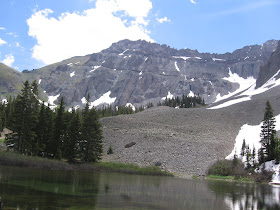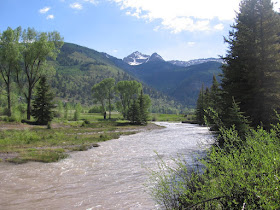The Valley Floor River Trail visits an area near Telluride in southwest Colorado that has been the subject of an intense legal battle in recent years between development and conservation.
I started my hike at the point where Colorado Highway 145 from the south makes a left turn to the west with the three mile spur into Telluride box canyon going to the east. This point is also a starting point for the Galloping Goose Trail and the Telluride Bike Trail.
The trail hugs the south side of the valley up against a steep slope thick with spruce, fir and aspen trees. Several small streams spill down to join the San Miguel, one of the few streams in Colorado without a dam on it. The story I gathered from internet sources is that in December of 1999, San Miguel Valley Corporation (SMVC) revealed updated plans for development on the Valley Floor.
These plans included a large hotel complex, a gondola link to the ski town Mountain Village which is just over the south ridge, an 18-hole golf course, commercial areas, condominiums, and single homes.
On July 3, 2000, a public demonstration drew approximately 1,500 people to the County Courthouse steps for a Rally for the Valley, with participants roaring, “Free the Valley.” As reported by The Denver Post, “Dreadlocks cozied up to designer pants suits, movie stars linked up with ranch hands, tie-dyes connected to Ph.D.s, second-home owners gripped tent dwellers, tots hung on to retired miners. It must have been quite a scene.
Walking around town you see the odd mix drawn to this very scenic and trendy town, and I'm always impressed by the very nice looking dogs.
Some of the peaks of the Sneffels Wilderness Area are visible are visible as you stop and gaze along the river banks. There is the Telluride Bike Trail on the north side of the Valley that gives a view back toward the more heavily forested south side. The Bike Trail can be used to make a loop trip for both hikers and bikers.
On June 25, 2002, Telluride residents voted 609- 385 in a special election to pursue eminent domain for attainment of 570 acres on the south side of the Valley Floor to be placed under a conservation easement in perpetuity. The dispute was whether the town had the legal right to do this. After four months of deliberation, the Colorado Supreme Court ruled 6 – 1 in favor of the Town of Telluride in its long-standing effort to acquire the 570-acre gateway meadow known as the Valley Floor.
About one mile west of Telluride, the
Boomerang Road descends from the area near the golf course and makes a junction with the Valley Floor River Trail.
This is a steep old road passing through the Spruce-Fir Forest. At the top of the Boomerang Road, there are some good views toward the mountains that are directly across. I took about 1:15 to complete the three mile walk. Once in the town of Telluride you will probably want to continue on the in town part of the River Trail.
In the in town part of the River Trail here has been an ongoing project for restoring the natural habitats of the San Miguel River below that have been damaged over the years by mining and resort development. Improved aquatic habitat in the river channel by creating a variety of natural appearing features including riffles-pools-glides and in stream cover.
 The site appears to be well protected, apparently on private property with fences deterring any poking around inside the old structures. They certainly had a good view from up here, around 11,000 feet up.
The site appears to be well protected, apparently on private property with fences deterring any poking around inside the old structures. They certainly had a good view from up here, around 11,000 feet up. Water for the mining activity was probably managed using the Alta Lakes which appear to have been engineered using small earthen berms. The Alta town site was the center of mining activity in the Alta-Gold King area from 1877 to 1948. A fire in the mill ended the activity here. It is about four miles along the steep Alta Lakes Road to the town of Alta.
Water for the mining activity was probably managed using the Alta Lakes which appear to have been engineered using small earthen berms. The Alta town site was the center of mining activity in the Alta-Gold King area from 1877 to 1948. A fire in the mill ended the activity here. It is about four miles along the steep Alta Lakes Road to the town of Alta. Alta was one of the first Industrial sites to use alternating current electricity. A long distance transmission line was completed from the Ames power plant on the San Miguel River on June 21, 1891.
Alta was one of the first Industrial sites to use alternating current electricity. A long distance transmission line was completed from the Ames power plant on the San Miguel River on June 21, 1891. 







 Normally, a paved trail next to a highway wouldn't be a hikers choice, but the views in the Telluride Valley Floor are worth it and the Bike Trail completes a six mile loop with the River Trail on the south side of the canyon. The Bike Trail includes a tunnel under the spur route into Telluride town. Towards the west end of the trail the San Miguel River starts to come more into view.
Normally, a paved trail next to a highway wouldn't be a hikers choice, but the views in the Telluride Valley Floor are worth it and the Bike Trail completes a six mile loop with the River Trail on the south side of the canyon. The Bike Trail includes a tunnel under the spur route into Telluride town. Towards the west end of the trail the San Miguel River starts to come more into view. 











